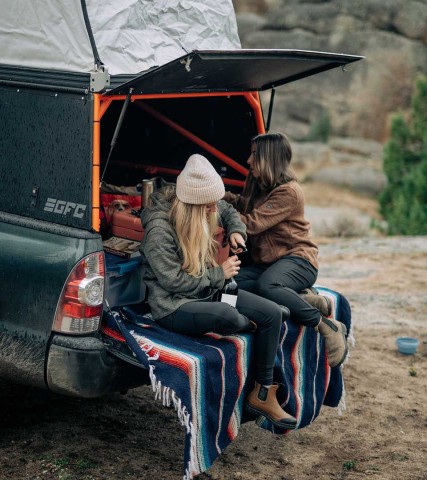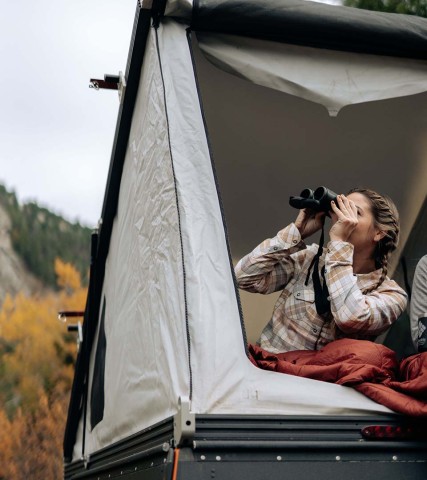- 1. Key Takeaways
- 2. What is a Rooftop Tent?
- 2.1. How does a rooftop tent work?
- 2.2. Benefits of Rooftop Tents
- 2.3. What to Consider Before Purchasing a Rooftop Tent
- 3. Types of Rooftop Tents
- 3.1. Soft-shell
- 3.2. Hard-shell
- 4. Our Top Picks of Rooftop Tents
- 4.1. Thule Tepui Foothill
- 4.2. iKamper Skycamp Mini 3.0 Rooftop Tent
- 4.3. Smittybilt GEN2 Overlander Tent XL
- 4.4. Roofnest Sparrow EYE
- 5. Our Tips on Preparing For an Overlanding Trip
- 6. Final Thoughts
- 7. FAQs
- 7.1. How safe are rooftop tents?
- 7.2. How much does a rooftop tent cost?
- 7.3. Do rooftop tents use more fuel?
- 7.4. Are rooftop tents noisy?
- 7.5. What is the lifespan of a rooftop tent?
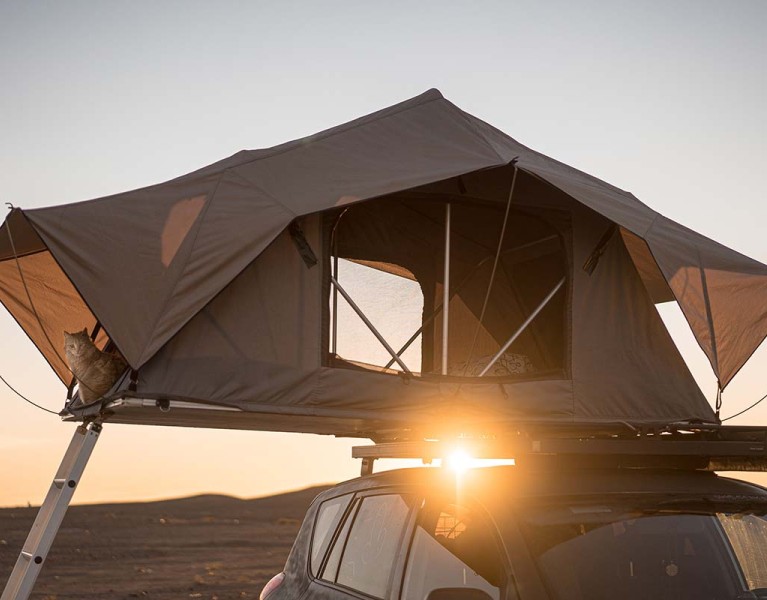
KÜHL’s Top Rooftop Tent Picks for Overlanding Trips
Table of Contents [Show]
There are so many options when it comes to sleeping under the stars. There are swags, ground tents, and hammocks, and you can also sleep inside your vehicle. And now overlanders in the US have borrowed another hack from the Aussies- car tent camping. If you enjoy off-roading and would appreciate a more convenient sleep system, try a rooftop tent.
It’s just as it sounds: an innovatively designed tent that affixes to your car’s rooftop or truck bed. Yes, sleeping in a car tent is totally safe, so long as you choose a model that aligns with your car’s dynamic weight limit, roof type, and type of racking. Simply put, most camping car tents are not a one-size-fits-all piece of equipment. If you want to learn more, take a look at our beginner's guide on pickup truck camping.
Let’s discuss some key considerations when choosing rooftop tents for the perfect car camping spots. Or skip ahead to our reviews of our best picks on the market.
Key Takeaways
- The essence of a rooftop tent is the freedom to set camp anywhere your vehicle goes.
- Hard-shell roof tents shine in durability, quick setup, and aerodynamics. Soft-shell rooftop tents win in terms of affordability and lightweight design.
- Soft-shell roof tents typically last 5-10 years. Hard-shell car roof tents typically last 10-15 years.
- Rooftop tents take 30 seconds to 5-10 minutes to deploy.
- The dynamic and static ratings are the major considerations when buying a truck roof tent for overlanding.
What is a Rooftop Tent?
A roof tent is a folding shelter installed on a camping vehicle's roof or bed. Roof tents typically consist of canvas walls and roofs, aluminum piping frames similar to tent poles, and a sturdy base made from aluminum or plywood.
Your rooftop camper will also come with a built-in mattress, allowing you to drop sleeping pads off your camping checklist. And, of course, there’s the ladder that makes it a breeze to access your elevated abode.
How does a rooftop tent work?
It’s very simple! You start by mounting the tent to your vehicle’s roof or bed before hitting the road. Different rooftop tents have different installation methods. But the process is generally simple:
- Position the tent on your vehicle’s rack and slide it into position.
- Use the provided mounting hardware to bolt the tent onto the roof rack.
- After reaching your destination, pop out or fold out the tent to set it up.
- When it’s time to close shop, fold everything into the container and hit the road again.
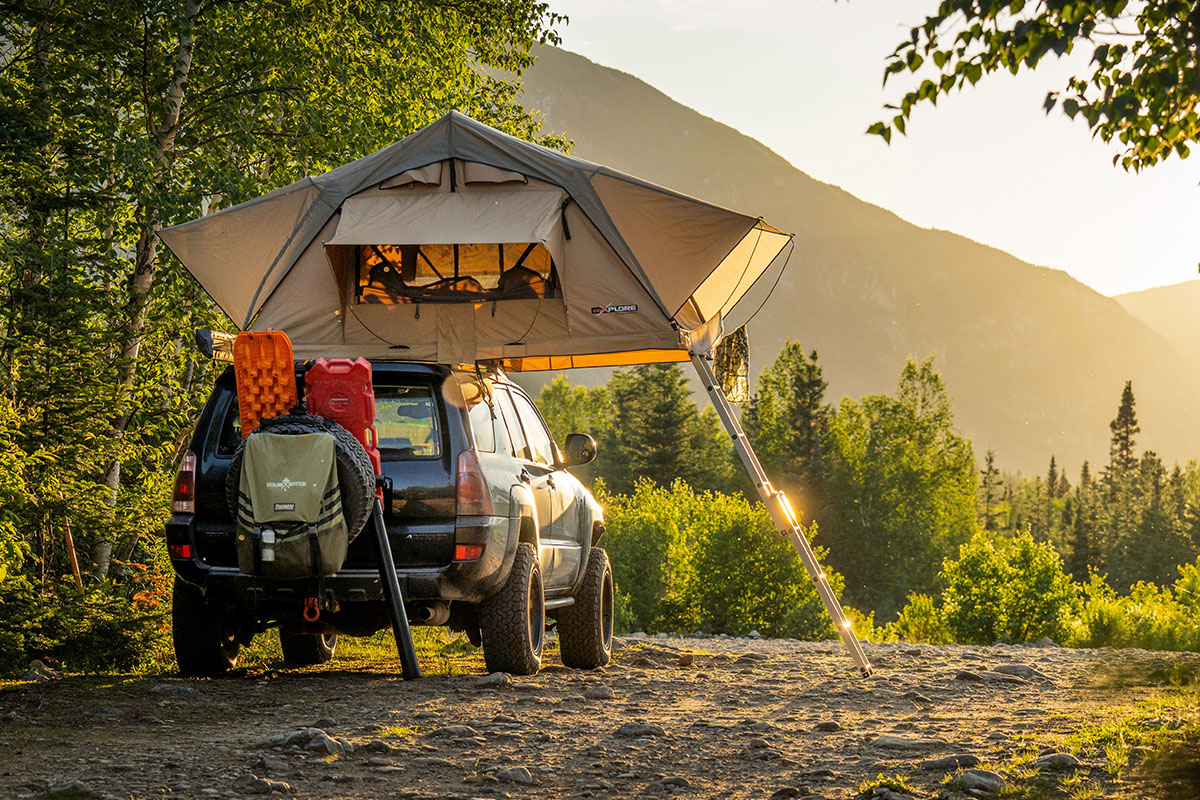
Benefits of Rooftop Tents
Fast and easy to set up and fold
Setting up a rooftop tent generally takes 60 seconds to anywhere between 5 and 10 minutes, depending on the complexity and design. Folding a camper on top of a truck takes almost twice the time it takes to erect it. But you can expect it to be much easier and faster than folding an on-ground tent because there are no stakes and ropes to collect. And because the tent stays mounted on your vehicle, it’s ready to spring back up again when you get to your next camping spot.
Saves up space in your vehicle
Your tent and mattress are the bulkiest pieces of gear you have to contend with when overlanding. The beauty of the best rooftop tents is that they occupy the additional storage space on your car roof alongside your mattress, pillows, and blankets. Thus, they save tons of space for other essential camping gear inside your car.
You can camp anywhere, anytime
Another reason overlanders add a rooftop tent to their camping gear is the convenience of camping anywhere. You can camp anywhere your car goes, so long as it’s safe and legal. Even cooler, your campsite is unaffected by level-ground terrain and weather conditions. So no worries about sharp sticks and rocks puncturing your air mattress or sleeping pad. Or having a chilly ground as your air mattress base on a sub-40 night.
Plus, they can be damn comfortable
It may take a few nights to get used to sleeping in a car top tent if it’s your first time. But after the short break-in period, you can’t beat the comfort of sleeping on a high-density mattress with real blankets, away from the critters. Rooftop tents also tend to sleep warmer than typical camping tents thanks to their thicker canvas construction and distance from the ground. And if your greatest fear when camping is encountering a big, scary animal, sleeping closer to the stars may offer relief.
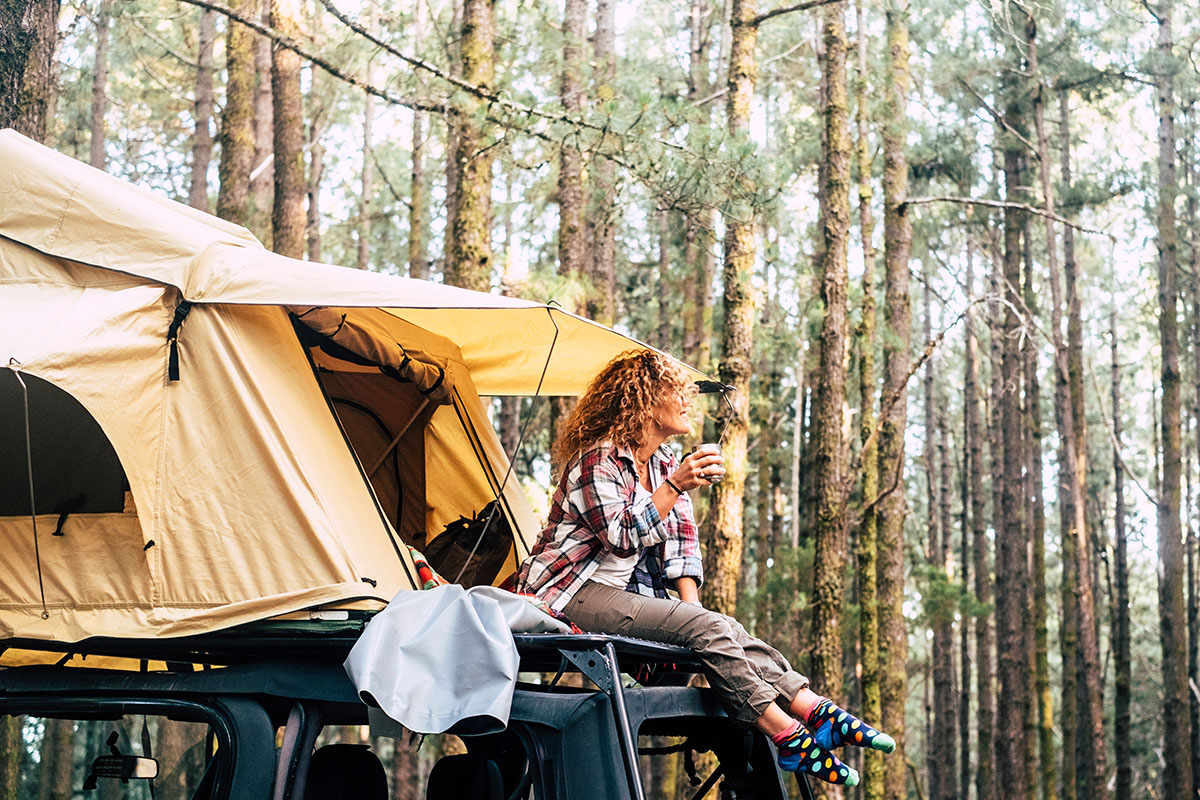
What to Consider Before Purchasing a Rooftop Tent
Your top-of-the-truck-tent will be the most expensive equipment in your overlanding gear. And although most brands accept returns, the process is often more challenging, especially for models only available online. It really pays to get it right the first time.
Tent Weight Vs. Your Rack’s Max Dynamic and Static Load Ratings
The dynamic load rating is the maximum weight your roof can handle when in motion. Exceeding this weight limit can affect your vehicle’s handling capabilities, significantly increasing the rollover risk. Add the weight of the roof rack, rooftop tent, and other gear and compare it to your car’s dynamic weight capacity. Most rooftop tents weigh 100-200 lbs.
The static load rating is the maximum recommended weight a vehicle can handle while stationary. It’s typically several times higher than the dynamic weight rating.
Size
When choosing the best rooftop tent in terms of size, consider how many people will be sleeping in it and the type of gear you want to have inside.
Two-person rooftop tents are the most common in the market. They are typically 2.4m in length and 1.4m in width and will comfortably fit a queen mattress. These are the best for couples or two adults and a child or an accompanying fur child. You’ll also find a few huge rooftop tents measuring up to 3.5m by 2m. These are the best for larger families because they can fit a large mattress. A rooftop tent 2.1m long by 1.2m wide will have enough space for a solo overlander and extra gear, for instance, a heater when winter camping.
Ease of Set Up
Another crucial consideration when comparing the best truck top tents is how easy they are to mount and pitch. Most of these require at least two people to mount on top of the rack system. After installation, the best roof tent should be a breeze to pitch and fold down solo. This is particularly crucial if you are planning to car camp alone.

Types of Rooftop Tents
Soft-shell and hard-shell are the two major categories of rooftop tents. They differ in terms of construction materials, which ultimately affect their cost, ease of setup, weight, aerodynamics, interior space, and durability. Let’s have a close-up look at hard-shell and soft-shell rooftop tents and their pros and cons.
Soft-shell
Soft-shell roof tents for trucks are mainly made of foldable, more pliable materials, particularly nylon and canvas, hence their name. Soft-shell roof tents are generally more affordable than their hard-shell alternatives. And that’s partly why they are the most common out there.
Pros
- They are relatively more budget-friendly. The best soft-shell roof tents for car camping cost $700-$1400+.
- They are lightweight because they don’t have a hard shell, meaning they can go on a lot of vehicles.
- Footprint-wise, soft-shell tents can be very roomy. Some can accommodate up to four campers.
- The best soft-shell roof tents allow you to add awnings and annexes. The added covered area can be ideal for cooking, resting, and storing your rain gear and soiled hiking clothing.
Cons
- They are generally slower to pack down because there’s a lot more material to tuck and a cover to zip back on.
- While soft-shell roof tents are more durable than on-ground tents, they are no match for hard-shell models. Soft-shell roof tents last 3-5 years, but the best can hit 10 years with proper care. In contrast, hard-shell rooftop tents can last 10-15 years.
- They cause the most drag, and this will have an effect on your miles per gallon.
Hard-shell
Hard-shell roof tents get their name from their solid outer casing. Their top and bottom pieces are mainly made of aluminum, fiberglass, or ABS plastic, while the sides are fabric.
Pros
- They are the fastest to set up and pack down. The best hard-shell rooftop tents have a pop-up or lift mechanism that reduces setup time to less than a minute. They take around five minutes to put away.
- Some hard-shell tents have additional creature comforts, such as solar chargers and charging ports.
- When packed down, the top and bottom parts turn into a roof box, enclosing the fabric walls, mattress, and ladder.
- In terms of durability, hard-shell tents can handle inclement weather, from snow to windstorms, pretty well.
- Hard-shell tents are considerably quieter than soft-shell tents during storms.
- These tents are designed with aerodynamics in mind for improved fuel economy.
Cons
- They are way costlier than soft-shell rooftop tents. Expect to spend upwards of $2000 if you are eyeing a hard-shell roof tent.
- Hard-shell tents are significantly heavier, making them ideal for larger vehicles and toy haulers.
Our Top Picks of Rooftop Tents
Thule Tepui Foothill
Best Soft-shell Rooftop for Mountain Bikers and Kayakers
Thule has been in the outdoor gear industry for over eight decades. And we have to commend them for their innovative designs. The Tepui Foothill is for overlanders who want the convenience of a rooftop tent but still want to be able to carry other cargo on their roof racks.
This rooftop tent measures 83 x 24 x 9.5 inches when stowed. This narrow form factor frees about half of your roof rack space for a bike, ski rack, kayak, roof box, or any other outdoor gear.
Deployed, the Thule Tepui Foothill measures 84 x 47 x 37 inches. It offers a sleeping footprint of 84 x 47 inches, which is super-roomy for one person and cozy for two people. The plush foam mattress with a removable cover is not the thickest we have seen at 1.6 inches. But it should guarantee a comfortable and secure place to sleep and relax after a day of exploration.
The tent is symmetrical and has two oversized entrances on both sides. You also have two wide windows on each end and dual skylights for excellent airflow and stargazing when the rainfly is removed. Plus, there are two storage pouches for your phone and other small gear.
The main tent is made of UV- and mold-resistant 600D polyester ripstop, allowing you to use it year-round. The rainfly is made of nylon and attaches quickly in wet weather.
The Tepui Foothill takes around 10 minutes to set up and break down. But there are lots of small steps involved, which can be a trade-off, especially during inclement weather. We also wish the ladder fits under the tent's cover instead of occupying the valuable space in the trunk.
The Thule Tepui Foothill rooftop tent weighs 122 lbs and has a static weight capacity of 600 lbs.
Pros
- Spacious sleeping area for two
- It takes only half of the vehicle's roof
- Plenty of ventilation and airflow
- You can leave your cargo on the roof when the tent is open
Cons
- Packing it away is a process
- The ladder stays inside the car
iKamper Skycamp Mini 3.0 Rooftop Tent
Best Hard-shell Rooftop Tent for Small Cars and Truck Beds
iKamper is a regular name in most discussions of the best rooftop tent brands. And not just because they design and manufacture their products in South Korea but also because they listen to customer feedback to make subtle changes in their new releases. That's what they did with the Skycamp Mini 3.0, which adds a lot of improvements to the Skycamp 2.0.
The Skycamp Mini 3.0 (2-3-sleeper model) is a good option if you want a rooftop tent that will work nicely on a small vehicle (like a Mini Cooper or Subaru Forester) or your Tacoma's short bed. But it also fits just about any vehicle, including SUVs and long sedans.
The Mini 3.0 has a footprint of 57 ½ x 54 ¾ inches and closes down to a height of 13.5 inches. It opens to reveal a 29.4 sq. ft. sleeping area (82 ¾" x 51 ¼") with a 45" headroom and a 9-zone, 2.25" mattress made of insulated polyfoam. Two windows with mesh panels to keep insects out will offer you panoramic views of your surroundings.
The hard shell of the Mini 3.0 is considerably thicker than its predecessor's. The shell case is made of double-layered fiber-reinforced plastic (FRP) and has a 1" air insulation. The tent fabric is made of breathable, blackout, 300gsm polycotton canvas, while the rainfly is made of waterproof polyester 75D ripstop. The floor is made of durable, insulating honeycomb aluminum panels and has two weatherproof ports to run cables and wiring for your electronics.
As it's the case with the best hard-shell car tents for camping, the Skycamp Mini 3.0 opens in a minute or two. Tear-down may take a few more minutes, but it's just as easy. It's also a selling point that the Mini 3.0 does not occupy all the space on your roof rack when stowed.
The Skycamp Mini 3.0 weighs 125 lbs and has a static weight capacity of 900 lbs. The ladder is rated at 300 lbs and stored inside the tent when traveling.
Pros
- Lightweight for a hard-shell rooftop tent
- Works with most vehicles, including small and compact cars
- Easy setup and take-down
- Quality construction for all-season use
Cons
- High price point
- The windows could be bigger
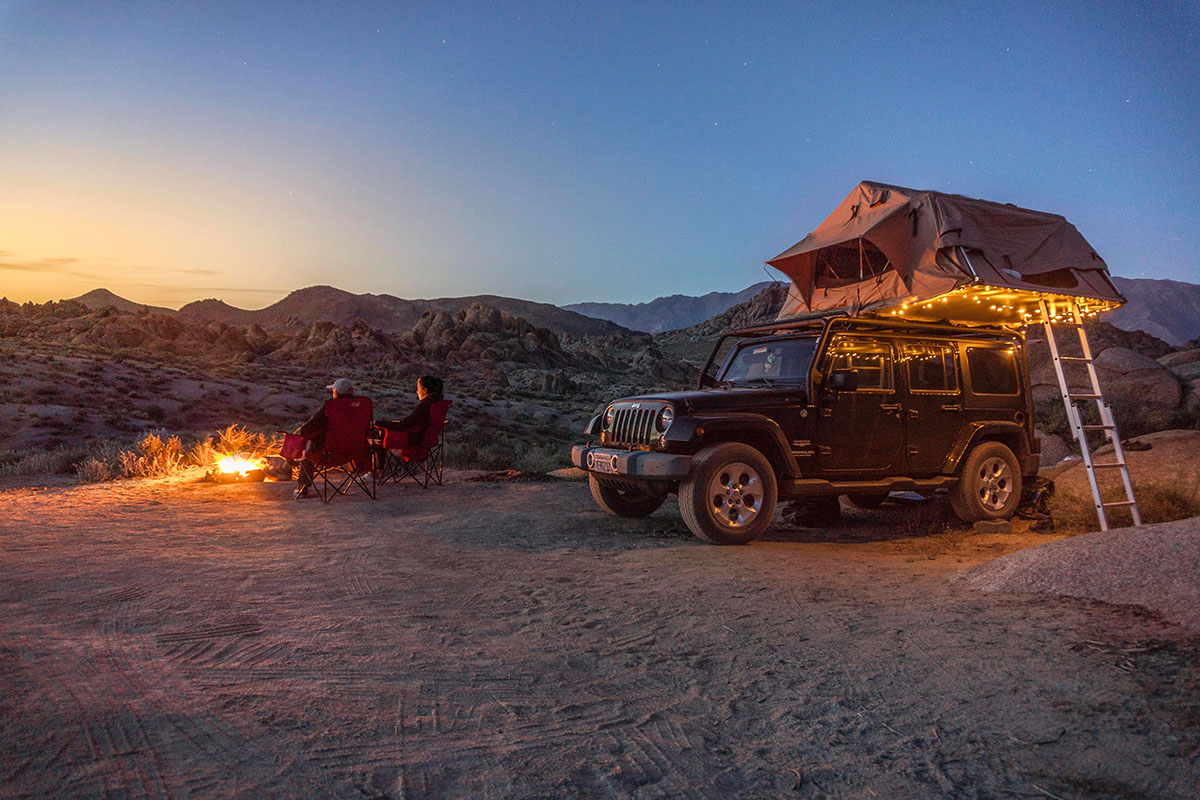
Smittybilt GEN2 Overlander Tent XL
Best Lower-priced Rooftop Tent for 4 People and Tall Campers
If you want to experience the fun of exploring the backcountry as a family, consider the Smittybilt Gen2 Overlander XL. This would be our top recommendation if you want a spacious truck-top tent that can accommodate four people. Actually, this model also allows you to attach an annex, thereby creating an extra room.
The walls of the Gen2 Overlander XL are made of 600D heavy-duty ripstop polyester. The top is waterproof and polyurethane-impregnated. The floor is made of an aluminum/polyurethane sandwich and has a weight load rating of 770 lbs. Your tent also comes with a 420D Oxford rainfly and a telescopic aluminum ladder.
The Gen2 Overlander XL has two huge entrances, two mesh windows, and two mesh roof openings. In other words, you can't beat the level of ventilation and the panoramic views inside the tent. The included king-size mattress is two inches of high-density foam.
Setting up the Smittybilt Gen2 Overlander Tent XL takes 10-15 minutes because it involves staking the fly down. Depending on the setup, it takes a single person about 20 minutes to take it down.
The Smittybilt Gen2 Overlander XL measures 122" W x 76" L x 51" H when deployed and 78" x 49" by 12" when packed. It weighs 118 lbs.
Pros
- Excellent visibility and ventilation
- Relatively easy to set up, given its size
- Spacious for up to four campers
- The ladder stays at the top
Cons
- Has lengthy take-down
- Not the most comfortable mattress

Roofnest Sparrow EYE
Best for Design and Fuel Economy
If fuel economy is a major concern, the Roofnest Sparrow Eye demands your attention. Also, at around three grand, the Sparrow Eye is a top contender in most recommendations for affordable hard-shell rooftop tents.
The Roofnest Sparrow Eye is a pretty compact car roof tent measuring 85" (L) by 50" (W) and 11.5" (H) when closed. It's not vehicle-specific, meaning it works well on all types of vehicles.
The Sparrow Eye is 83" long and 49" wide on the inside, with a maximum headroom of 44". In other words, you'll have enough room to stretch out even if you are tall. This 2-sleeper model has a large entrance and two large windows. The door and the windows have canvas zip closures and a mesh layer to keep pesky insects out while allowing air to flow in. The tent also has a rain skirt around the three sides.
The Roofnest Sparrow Eye comes with a 2.8" memory foam mattress with a cover. You'll also get an anti-condensation mat that gives the mattress a soft pillowy feel.
As for construction materials, the shell is made of fiberglass-reinforced ASA/ABS, while the fabric is 280GSM coated polycotton. The aluminum telescopic ladder is 8.5' long.
Like most hard-shell rooftop tents, the Sparrow Eye deploys in seconds thanks to the built-in gas struts. Packing it up shouldn't take more than two minutes, assuming you've had your morning cup of coffee.
The Roofnest Sparrow Eye weighs 130 lbs and has a static weight capacity of 650 lbs.
Pros
- Luxurious memory foam mattress
- Quick and easy setups and take-downs
- Stylish design
- More affordable than most hard-shells
Cons
- The location of the door in the rear makes it difficult to mount the ladder if you have a stock spare wheel at the back
- Small windows
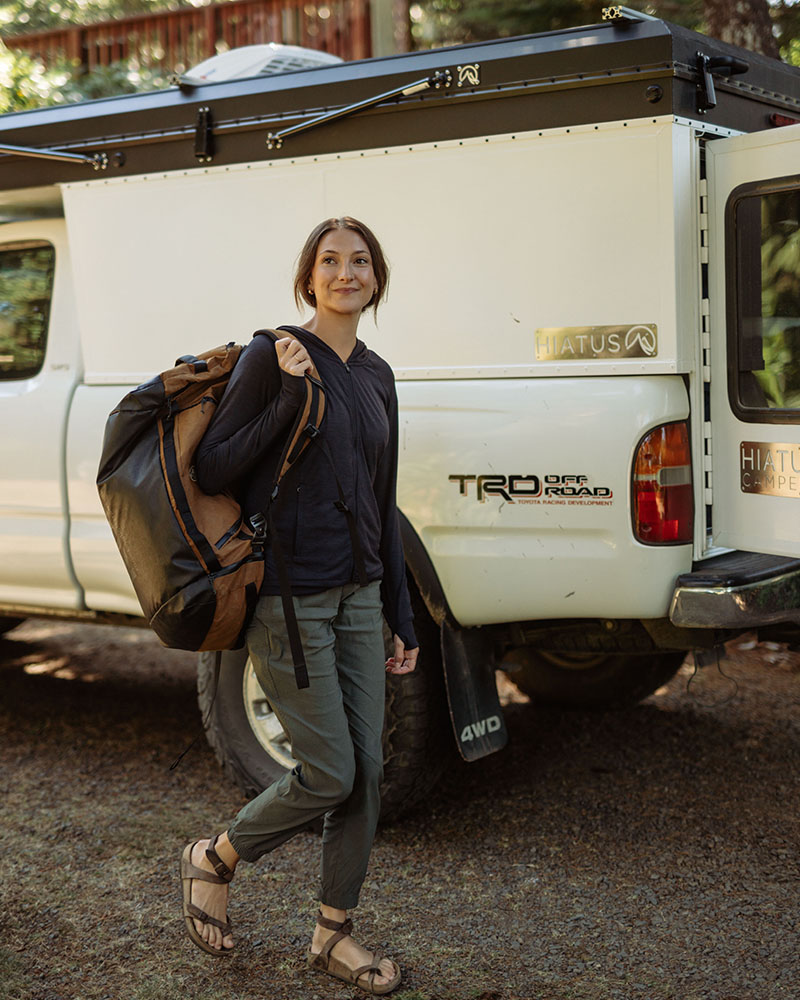
Our Tips on Preparing For an Overlanding Trip
Like a regular road trip, an overlanding trip is only as safe and as fun as you plan it to be. Here are a few tips on the type of gear to pack for an overlanding trip:
- High lift jack- crucial when traveling through rocky trails that are likely to deflate your tires.
- A dedicated GPS device.
- Paper maps- these will come a lot in handy in case your GPS device and phones start playing games on you.
- Recovery boards- they provide additional traction, helping you get out of sticky situations.
- A portable tire inflator and deflator- help when you need to level the vehicle when camping on an uneven surface.
- First aid kit and a pet-specific emergency kit if your furry friends are tagging along.
- Flashlights and headlamps to make nighttime walks safer.
- A portable car jumper kit.
- Tire repair kit.
- A portable solar-powered power station like Jackery to help recharge your devices.
Final Thoughts
Overlanding excursions or expeditions are too exciting not to have on your bucket list. It rewards you with some solitude from the crowds while broadening your perspective of the world and life in general.
The beauty of having a tent on top of your truck or car is moving with your campsite no matter how far your adventurous spirit takes you. So, like a smart overlander, choose the best rooftop tent for your vehicle and budget and make the road your home.
Featured image by: Wirestock.
FAQs
How safe are rooftop tents?
Rooftop tents are as safe as ground tents provided you mount and deploy them according to the manufacturer’s instructions.
How much does a rooftop tent cost?
Rooftop tents range from $1000 to $5000, depending on the type. Soft-shell rooftop tents cost $1000 to $2000. The best hard-shell tents cost north of $2000.
Do rooftop tents use more fuel?
Yes. A truck roof tent will affect your hourly mileage because they add drag and weight.
Are rooftop tents noisy?
Rooftop tents can be noisier than ground tents because they are placed high off the ground. But this issue affects soft-shell rooftop tents more than their hard-shell alternatives.
What is the lifespan of a rooftop tent?
If you treat it well, a good soft-shell truck tent topper should last 5-10 years or even longer if you don’t use it regularly. In contrast, hard-shell tents can last 10-15 years.
